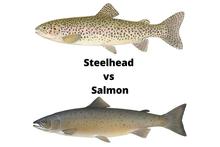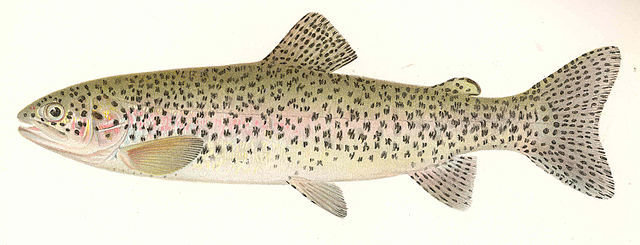This article may contain affiliate links. If you make a purchase after clicking on a link we may earn a small commission at no extra cost to you. As an Amazon Associate, I earn from qualifying purchases.
Steelhead Trout vs Salmon – What’s the Difference?

The rivers throughout North America are full of a variety of different fish species, but few are as popular as steelhead trout and salmon. These two fish are prevalent across much of the northwestern United States and Canada and are exceptionally fun to catch on a rod and reel.
If you’re one of the many anglers who isn’t able to tell the difference between steelhead trout and salmon, we’ve compiled this article to serve as a guide for doing so.
Steelhead Trout vs Salmon Overview
Both the steelhead trout and salmon are actually two very different species of fish that happen to share quite a few similarities in their appearance and habitat. They are both salmonid species and can exist in saltwater or freshwater, depending on their specific circumstances and habitat.
Steelhead trout are actually rainbow trout that basically have different lifestyles. While these fish are capable of living their lives in either types of water, steelhead are simply a rainbow trout that lives part of its life in the ocean and will swim up into freshwater rivers during their migration inland during the spawn.
Salmon are very much the same in this regard and they are known to spend most of the year in saltwater environments around the coast before making their way into the inland freshwater rivers and streams to lay their eggs for the spawn.
In most cases, salmon are usually bigger than steelhead trout, but both of these fish species are capable of growing to be big enough to put up a serious fight against any angler with a rod and reel.
What is a Steelhead Trout?
The steelhead trout is a very distinct species that makes it one of the most sought-after fish in North America. They are what’s known as anadromous fish since they spend a majority of their time in saltwater before venturing many miles inland through freshwater rivers to spawn.

They are known by a few different nicknames including steelhead, rainbows, bows and steelies, depending on what region you’re in.
The fact that they live part of their lives in saltwater and move into freshwater for the spawn causes steelhead trout to develop differently than the common rainbow trout. Those that live in both saltwater and freshwater tend to grow much bigger than rainbow trout that live their entire lives in freshwater lakes or rivers and streams.
Most biologists agree that steelhead trout that live part of their lives in the ocean grow larger because they have a more diverse diet and are able to feed more heavily than rainbow trout that are relegated to freshwater streams or rivers. These fish live two or three years in freshwater followed by two to three years in saltwater environments.
Steelhead trout are known to hatch in rivers that have very fast-flowing waters that provide oxygen-rich habitat, as well as gravel-bottom throughout most of its length. Some of these fish will remain in freshwater throughout their entire lives while others will eventually make their way out into the ocean.
Their habitats are often disrupted by human activity on the rivers where these fish are known to spawn and there are many populations of rainbow trout that are land-locked due to their access to the ocean being blocked by dams or other structures.
There are large numbers of steelhead trout throughout the Pacific coast of North America, but the rainbow trout are one of the most prevalent fish in America’s rivers and streams.
There are plentiful numbers of steelhead trout ranging across much of the western Canadian coast and around Alaska, as well as around the eastern Asian coastline.
What is a Salmon?
The salmon is an integral part of many wild ecosystems across much of Alaska and Canada, as well as the Pacific Northwest. Everything from bears to populations of Native Americans have relied on salmon as a major food source for thousands of years.

These fish are found in cold, clear waters many miles inland, but—like the steelhead trout—they will also live a portion of their lives in saltwater environments.
There are actually five different unique species of salmon that can be found throughout the Pacific Northwest. However, each of these fish have minor differences in characteristics and behavior in comparison to one another.
All salmon are hatched from eggs that are laid in gravel-bottom rivers deep inland across the western coast of Canada and the United States.
Many scientists and biologists have been amazed at the salmon’s ability to travel many hundreds or even thousands of miles away from the freshwater streams and rivers where they are born, only to once again return when they reach full maturity and are ready to spawn.
This miraculous ability to return to their origin is not understood by even the most accomplished biologists, but the annual salmon run is one of the most exciting times for anglers, as well as animals that rely on salmon for their diet.
They are known for the distinct change that their bodies go through during this migration from saltwater into freshwater as the salmon will turn color and their body becomes a deep, crimson-red color after they spawn.
Many of them will die after they have laid their eggs, which in turn becomes food for a majority of animals, birds and insects that live along these rivers.
Disruptions in the migration and spawn of salmon can have devastating effects for the entire ecosystems around these waterways and their survival is pivotal to many other creatures in North America.
Size of Steelhead Trout vs Salmon
The steelhead trout and salmon are both fish that can grow to impressive sizes. Steelhead trout are known to grow to around 24 inches in length and will usually weigh up to about 25 pounds in optimal conditions and with the right diet.
However, they can grow to much larger sizes and it’s not uncommon for trophy anglers to catch steelhead trout that weigh in excess of 30 pounds in some areas.
The IGFA world record steelhead trout is said to be a massive 36-pound monster that was actually caught by an angler who had been trolling saltwater for salmon in British Columbia.
Salmon tend to grow larger than steelhead and are often the prime target of avid anglers who make the trip northward in the late winter and early spring to catch these massive migratory fish. They will usually grow to be around 30 inches in length at full maturity and adult salmon might weigh anywhere from 25 to 30 pounds.
The largest salmon ever caught was taken on Alaska’s Kenai River in 1985. The giant chinook salmon tipped the scales at more than 97 pounds. It’s common for anglers to catch 50-plus pound chinook salmon and the largest specimen ever discovered was a behemoth that weighed 135 pounds.
Differences Between Steelhead Trout and Salmon
There are notable differences between steelheads and salmon that are very evident to anyone who would compare the two species side-by-side. Here are the most common methods of identifying each one.
Color
The steelhead trout certainly earns its namesake as the fish’s body appears to have a very silvery, or ‘steel’ coloration. They will often retain the pink color on their sides and bellies until they grow to full maturity.
These fish can usually be spotted with relative ease from the banks of the rivers where they live and most accomplished anglers can readily tell a steelhead trout from a salmon.
The color of most salmon will range from silver to very dark, olive-green color. Salmon are sometimes known to have a steel-looking color that is very similar to that of the steelhead trout, but their skin is often darker than the steelhead.
Size and Shape
Most salmon will have more girth and mass than steelhead trout, which will be more slender and narrow. It’s no secret that salmon are capable of growing to much larger sizes than steelhead trout, so if you happen to catch a fish that weighs in excess of 25 pounds, you’ve likely caught a salmon. A steelhead will always have a more long, skinny profile than a salmon.
Mouth and Nose
One of the most reliable ways you can tell a steelhead trout and salmon apart is to look into the fish’s mouth. A steelhead trout will always have a mouth that’s very white in color while a salmon’s mouth will be much darker with white or black gums.
Salmon are also more likely to have a hooked upper and lower jaw, or kype compared to steelhead trout. The steelhead trout’s nose shape is much more round while the salmon’s head and nose is more pointed.
Conclusion
Both of these species are very popular among anglers and it’s easy to understand why. Their meat offers very tasty flavor and each fish has a reputation for putting up a formidable fight against a rod and reel.
